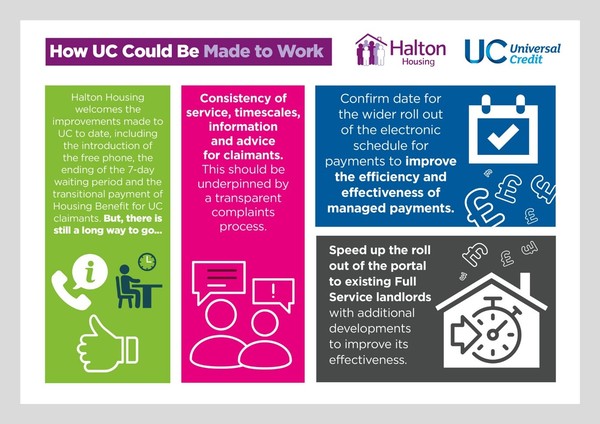You are viewing 1 of your 1 free articles
How Universal Credit could be made to work
Nick Atkin outlines three ideas to make the government’s welfare reform work more effectively
In February and November last year I shared several of the emerging problems from the early roll-out of Universal Credit (UC).
This has been operating at Halton Housing Trust since July 2016. Since then the Department for Work and Pensions (DWP) has made some welcome changes.
These have included the introduction of the free phone, the ending of the seven-day waiting period and the transitional payment of housing benefit for UC claimants.
But there is still a long way to go.
Most people I speak to are supportive of the overarching principle of UC.
At its basic level it addressed many of the criticisms of the previous legacy benefits system.
This had resulted in a complicated myriad of benefits, where thousands of people didn’t claim what they were entitled to.
Unfortunately the overarching principles have been eroded, as reductions have been made to fund austerity measures.
As the roll-out gathers momentum, what is clear is that the transition to UC is one of the single biggest risks most housing business models have faced for 30-plus years.
At its most basic level it places at risk up to 65% of most landlords’ income. This was previously paid in the form of housing benefit every four weeks.
Our own figures, as illustrated by an infographic here, show some of the key impacts we all need to be prepared for.
These show 24% of our customers are in receipt of UC, but owe 60% of the arrears. The increase in our arrears attributable to UC has risen by £277,000, while errors in processing have led to delays and costs with 15% of rent verifications being duplicated and every month 8% of payments made to Halton having the wrong number.
The impact of UC on arrears is significant.
Within Halton, while just 24% of our customers are in receipt of UC, this accounts for more than 60% of all arrears.
The average balance of customers on UC is £409. The average balance of these customers before they were in receipt of Universal Credit was £225.
While some of the early problems have been addressed, it still remains that the average difference between balances now and before UC (the ‘arrears tail’) is still significantly longer compared to housing benefit cases.
So what are the reasons why arrears are remaining higher than before? After working within a UC landscape for the past two years, some of the key factors are:
- The process of making claims leaving claimants without any money for five to six weeks (this has recently improved with changes to advanced payments)
- Cases with greater complexity of claims are now moving onto UC
- Inconsistent quality of budgeting/money management advice provided by the DWP
- Communication issues between the DWP, landlords and claimants (usually managed via the claimants’ online journal)
Another key impact to emerge has been the need to make an increased provision for bad debt within our business plan.
This is due to higher arrears levels, coupled with a higher proportion of UC tenancies failing within the first 12 months.
We are only at the tip of the iceberg. To date only 15% of all those who are to move to UC have done so.
"The one thing that kept me awake at night was how many more people we were going to have to employ to collect"
The remaining 85% are still to move across as part of a managed migration. This is three million households over the next three years.
The one thing that kept me awake at night was how many more people we were going to have to employ to collect what would be at the very best the same amount of money.
This is what underpinned our digital-first, self-serve approach.
This has enabled us to provide more intensive tenancy support for those people whose tenancies under UC are now at increased risk.
So, what else can be done?
In our latest infographic (below), we suggest three changes would have a disproportionately positive impact.
What is clear is that further tweaks and fine-tuning adjustments are going to be needed if we are to make UC work.
Our guesstimate is that this will take another two years, in a similar way to when housing benefit payments direct to landlords were first introduced 20-plus years ago.
There has been a welcome shift in the narrative and approach from the DWP.
Like many of us in housing, it recognises that only through a closer working relationship can we co-create the practical solutions.
We need to grab this opportunity with both hands if we are to help shape the future direction of Universal Credit, to support those people living in our homes who are in the greatest need.
Nick Atkin, chief executive, Halton Housing Trust













